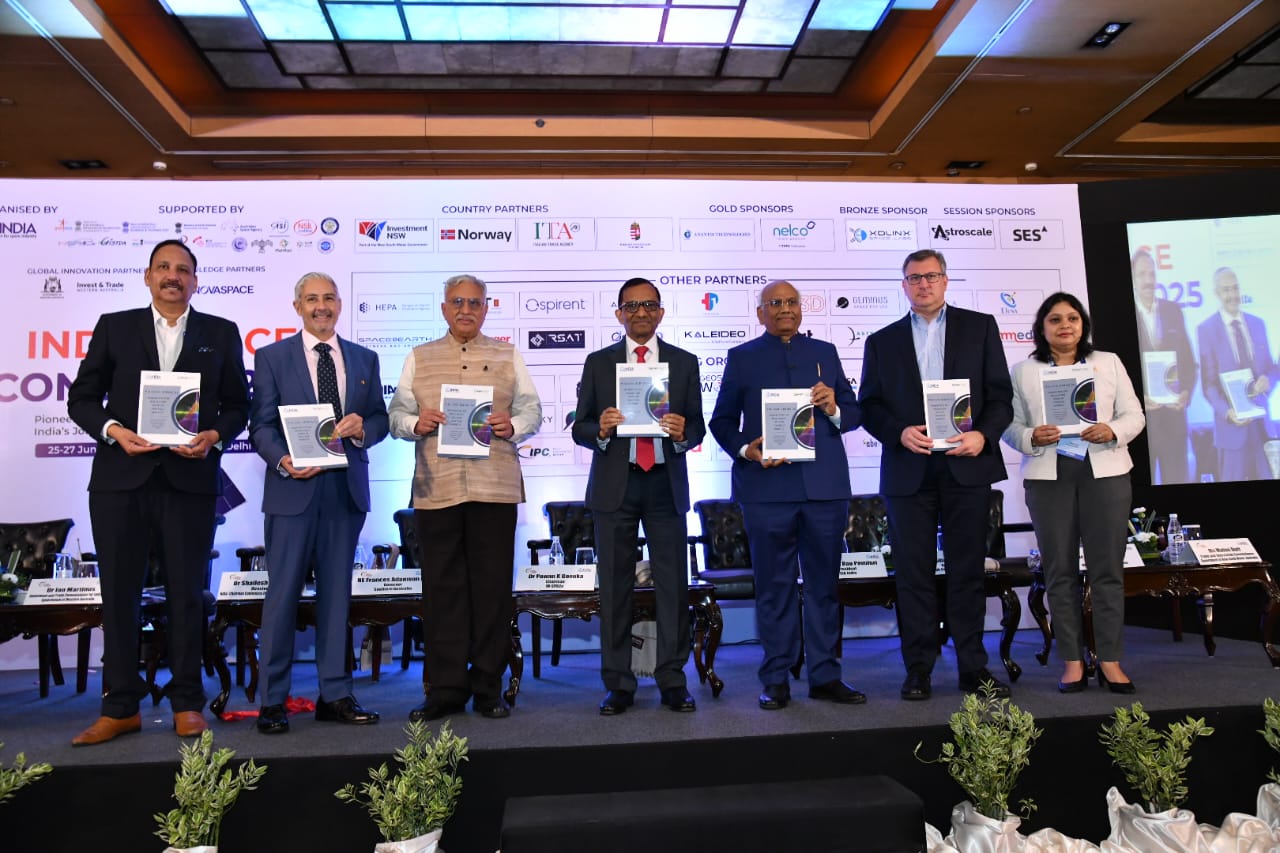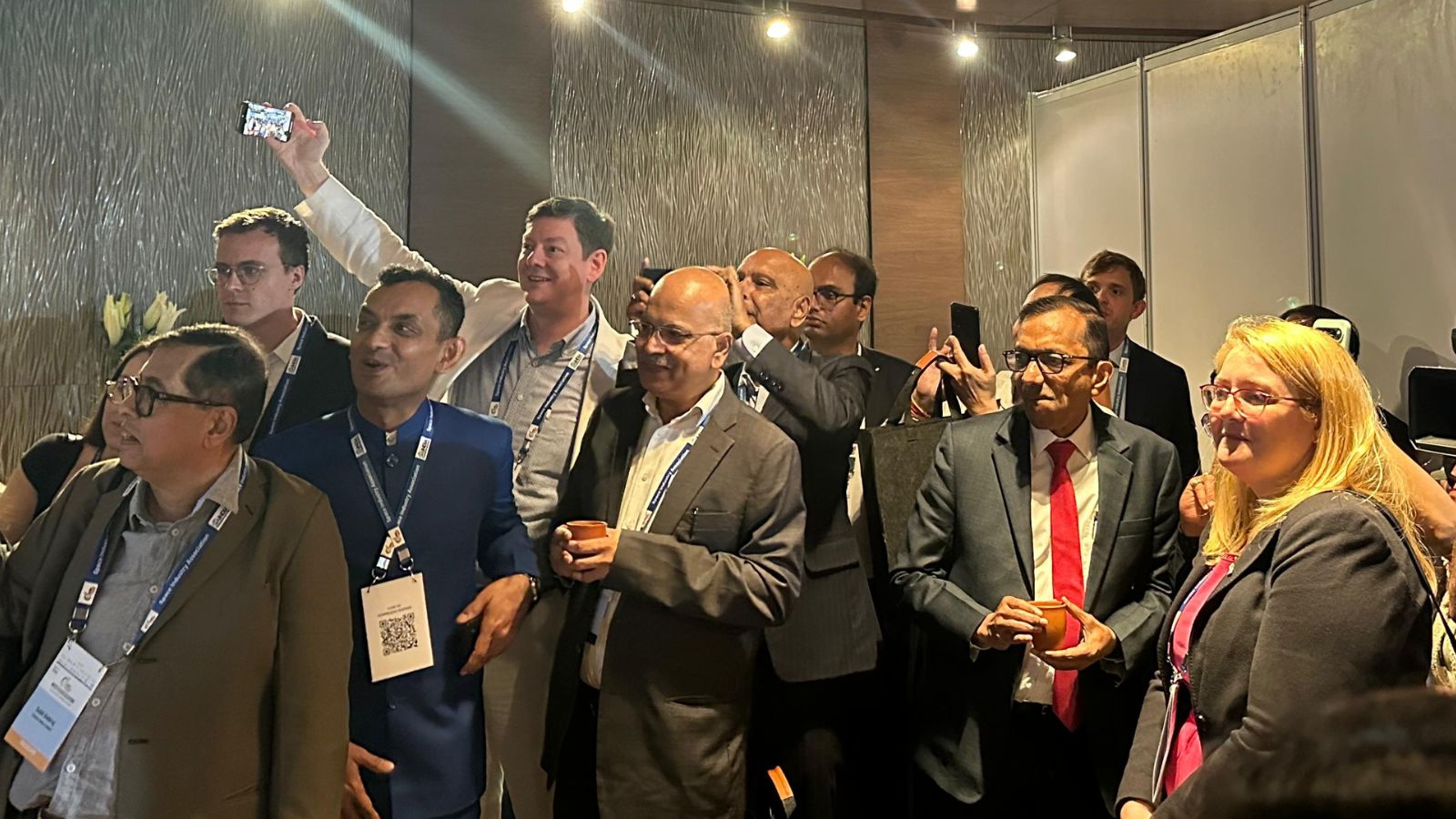The regulatory uncertainties raised by the satellite communications industry are all coming towards a resolution, said Dr Pawan Goenka, the chairman of The Indian National Space Promotion and Authorization Centre (IN-SPACe).
He also confirmed that the Indian government has awarded Global Mobile Personal Communication by Satellite (GMPCS) licences for low-earth orbit (LEO) satellite constellations to three satcom firms.
“We have given three licenses for LEO satellite constellation for communication already, and with all of these things, I hope that the digital divide that India has will be taken care of, and India will be able to take communication to every nook and corner at affordable rates very quickly,” Goenka said at the India Space Congress 2025 held by Satcom Industry Association (SIA-India) in Delhi on Wednesday, 25 June.
 The PRISM 2.0 report was released during the inaugural session Day of the India Space Congress 2025. (Image: SIA)
The PRISM 2.0 report was released during the inaugural session Day of the India Space Congress 2025. (Image: SIA)
The three-day conference hosted by the space industry association representing Hughes Communication, Agnikul Cosmos, etc., kicked off on the same day as the launch of the Axiom-4 mission to the International Space Station, with India’s Shubhanshu Shukla and three other astronauts on board.
The mission had faced multiple delays because of weather and technical issues before finally taking off from NASA’s Kennedy Space Center in Cape Canaveral, Florida, US at about 12pm India time on Wednesday.
“Many private sector companies have demonstrated their capability in multiple areas and also realised at the same time that space is not a game for kids. There is a lot that needs to be done, a lot of technological complexities. Even well-known launches get delayed multiple times in order to get it right. But that should not be a concern at all,” Goenka said.
Elon Musk’s Starlink recently became the third satcom firm to have a licence to operate in India, following Eutelsat’s OneWeb and Reliance Jio. While India is set to assign spectrum to satellite firms through administrative allocation instead of auctions, tensions between telcos and satcom companies have reportedly flared up again over the recent proposal by Telecom Regulatory Authority of India (TRAI) to impose a four per cent adjusted gross revenue (AGR) charge on satellite spectrum.
Story continues below this ad
The Cellular Operators Association of India (COAI), which represents Reliance Jio, Bharti Airtel, and Vodafone Idea, objected to the four per cent charge as being “unjustifiably low” compared to spectrum charges for terrestrial networks. In a rebuttal, the Broadband India Forum (BIF), an industry association comprising Big Tech and satellite companies, said that the level-playing field argument was flawed and misrepresented.
SSLV technology transfer
On the new initiative enabling the technology transfer of Small Satellite Launch Vehicle (SSLVs) by the Indian Space Research Organisation (ISRO) to commercial players, Goenka said that it was a clear example of the Indian government putting its money where its mouth is.
Earlier this month, fighter jet maker Hindustan Aeronautics Limited (HAL) won the first bid to commercialise the SSLV with the technology transfer set to take place over the next two years.
Goenka also revealed that final bids from startups and private companies to help build and maintain India’s first earth observation (EO) satellite constellation as well as the satellite-bus-as-a-service (SBaaS) project were set to come in over the next few weeks. “These two initiatives will allow the private sector to enter the space industry with the help of the government, not just financially but also to demonstrate what they can do now,” he said.
Story continues below this ad
The Rs 1,500 crore-EO satellite constellation project is aimed at gathering more geospatial data while the SBaaS initiative was launched by IN-SPACe to allow private players to design and build satellite buses where payloads and scientific instruments are typically held.
IN-SPACe stakeholder consultation
Sharing key takeaways from an IN-SPACe dialogue held with industry stakeholders two weeks ago, Goenka said that the autonomous government agency needs to become an orchestrator for the space industry in India.
He said that companies want IN-SPACe to “create and provide access to infrastructure, generate demand, facilitate private investment, be a single window connect, remove bottlenecks, and enable global collaborations.” Space industry stakeholders also demanded that ISRO pivot to mentoring and R&D rather than act as a service provider.
Passing the draft Space Activities Bill as quickly as possible is also a key industry demand, as per Goenka. The Indian Express had previously reported that a new draft of the Bill has been finalised and is ready for circulation to the stakeholder ministries. The legislation seeks to facilitate greater participation of private industry in space sector, and grant statutory powers to IN-SPACe.
Story continues below this ad
“We need a unified vision across all stakeholders in India. Synchronized and strategic progress needs to be made […] India’s space economy is moving from vision to reality, slowly but steadily. IN-SPACe will continue to be a committed enabler for the industry to move forward. It is time for the industry to lead with urgency, boldness, and a global mindset,” Goenka said.
ISC 2025 is expected to see participation from over 40 countries and more than 800 delegates, including space industry executives, researchers, policymakers, and other stakeholders. The inaugural session was attended by a lineup of dignitaries including Dr Thierry Klein, President, Nokia Bell Labs Solutions; Dr Shailesh Nayak, Director, NIAS; Dr Pawan Goenka, Chairman, IN-SPACe; Dr Neeraj Mittal, Chairman, Digital Commission; as well as diplomats such as Frances Adamson AC, Governor of South Australia, and Philip Green OAM, Australian High Commissioner to India.
“Over the next three days, ISC 2025 will feature 35 thoughtfully curated sessions, offering a comprehensive view of how satellite communications are driving digital transformation, how Earth observation is emerging as a national asset, and how navigation systems like NavIC are enabling precision and sovereignty,” Anil Prakash, the director-general of SIA-India, said.




Average Rating